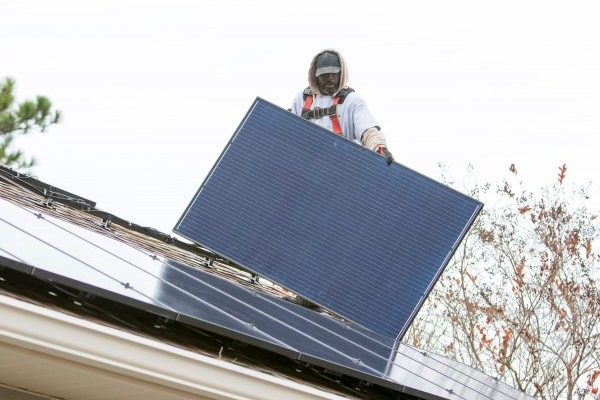Invest the fiscal stimulus to fight climate change

The coronavirus is a huge health shock; it’s also a triple whammy economic demand, supply and financial shock. Its sizeable demand component warrants large-scale fiscal stimulus. Governments around the world are scrambling to do exactly that: injecting trillions of dollars into their ailing economies through spending increases and tax cuts.
The global financial crisis taught us plenty of lessons on what to do, and what not to do, when it comes to fiscal stimulus: focus on the things that can be done quickly and easily, target cash payments to those on low incomes who are more likely to spend it, and target support to small businesses which are more likely to suffer a cash flow crisis.
But there is one grand economic and political lesson that remains true today: when you have a crisis, don’t waste the opportunity.
An economic crisis is the perfect time to undertake large-scale government spending. Not only is it vital for boosting demand when the private sector is weak, the usual costs associated with increased spending are significantly reduced. Inflation is non-existent, interest rates are low, exchange rates are less responsive to fiscal shocks, and the global scramble to get into safe assets means investors are throwing cash at governments, offering historically low interest rates for governments to borrow.
Spending should target priority areas that will both quickly stimulate the economy and address long-standing structural challenges.
Action on climate change ticks both boxes.
There is no shortage of large-scale projects in energy, agriculture and transport that both need investment and would help reduce carbon emissions. There is similarly no shortage of commentators who have recommended that fiscal stimulus target these projects.
But this misses the point. One of the critical lessons from the global financial crisis is that fiscal stimulus needs to be implemented quickly if it is to be effective. Large-scale infrastructure projects are ill-suited for fiscal stimulus because they are too slow to get off the ground and most require too much planning and preparation for them to be feasible. If such projects are ‘shovel ready’, then now is absolutely the time to start digging. Most are not.
What can governments do to both stimulate their economies and address climate change?
First, they should use this opportunity to stop doing the bad stuff. The big drop in oil prices provides the perfect opportunity to phase out fossil fuel subsidies and inject that cash directly into the pockets of households and businesses instead. The global fossil fuel industry received US$5.2 trillion of subsidies in 2017, according to the IMF. With oil prices already at rock bottom, this money could be withdrawn with few noticing the effect and given directly to low-income households and small businesses for a substantial boost to aggregate demand.
Second, governments could increase funding for environmental groups that hire local community members to plant trees, clean waterways and undertake initiatives to strengthen biodiversity and environmental resilience. Such initiatives boost employment, support demand and provide long-term carbon-reduction benefits. The timing of such an initiative, particularly in Australia given the devastation of the recent bushfires and huge demand for assistance, could not be more ideal.
Third, some of the fiscal stimulus going to households could be earmarked for energy efficiency spending on roof insulation, double glazing of windows, energy efficient lighting, energy efficient water heating and solar panelling. This would inject demand into these industries, protect jobs and reduce long-term carbon emissions.
With this comes a warning. The disastrous home insulation program in Australia, where subsidies during the global financial crisis resulted in the deaths of four workers after their employers recklessly disregarded workplace health and safety, highlights the need for careful management, including proper licensing and accreditation of suppliers and a demonstration of competence.
Finally, governments could consider using fiscal stimulus to encourage more people to switch to electric cars. Transport is among the largest contributors to carbon emissions and a temporary subsidy for electric car purchases and a discount on government registration fees would encourage those considering it to bring that decision forward, boosting sales in the short-term.
Although some of this benefit would fall on imports (depending on the domestic manufacturing of electric cars), it would provide immediate benefit to local dealers and services.
No excuse for inaction
This week’s lead essay on the East Asia Forum puts the spotlight on Australia and its excuse for climate inaction. Matthew Agarwala notes that, although it is unusual for a leader to downplay the importance of his or her country, that is on climate change the modus operandi of Australian Prime Minister Scott Morrison. Australia, the argument goes, accounts for only 1.3 per cent of global carbon emissions, so that any attempt to reduce those emissions would have minimal effect on the planet. Is this argument reasonable?
‘This is selective accounting,’ says Agarwala. Not only are Australians poised to experience 12 to 24 times greater damage from climate change compared to the global average, it ignores that Australians emit 3.37 times more CO2 per capita than the average global citizen, a number that jumps to 4.15 when including more potent greenhouse gasses such as methane. ‘As the world’s largest exporter of coal and second largest exporter of liquefied natural gas’, Agarwala argues, ‘Australia’s fossil fuel exports introduce a further 565.72 megatonnes of CO2 into the global supply chain’.
This ‘selective accounting’ also neglects to mention that most countries are in the same boat as Australia, contributing relatively little in terms of direct global emissions. If all countries were to adopt the same approach as Australia, the result would be runaway climate change.
‘The key point that Australia’s leaders and citizens are yet to grasp is that the location of emissions is separate to the impacts of climate change’ warns Agarwala. ‘Building on work by Stanford University climate economists, Australia is expected to incur between 4 and 8 per cent of all climate damage’ says Agarwala. ‘With just a third of 1 per cent of the global population, Australia’s per capita economic losses may be 12 to 24 times that of the average global citizen’.
Agarwala shows that Australia has more to gain from global climate action and more to lose from inaction than most. It has a direct and immediate incentive to push for transition to a low carbon future. ‘Australia could take a leadership role in developing and diffusing new technologies for green growth across the region’ he says. ‘If Australia phases out fossil fuel exports in favour of human capital exports such as engineering and technology, both sides could gain’.
With economies in free-fall, all governments, including Australia’s, are on the hunt for opportunities to stimulate their economies while, ideally, addressing long-term challenges. Action on climate change provides a raft of opportunities to do both. As the old saying goes, you should never waste a good crisis. Now is the time for bold action on both fronts.
Based out of the Crawford School of Public Policy within the College of Asia and the Pacific at the Australian National University, the Forum is a joint initiative of the East Asian Bureau of Economic Research (EABER) and the South Asian Bureau of Economic Research (SABER).














